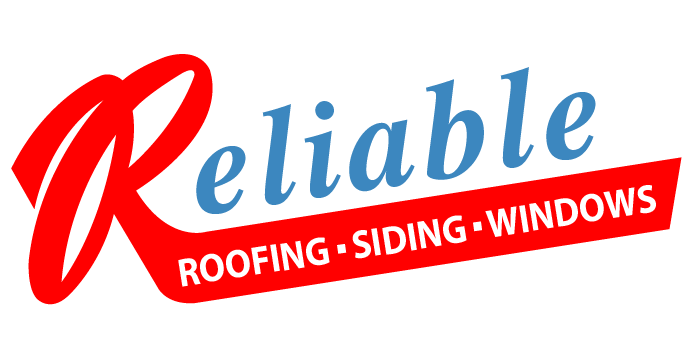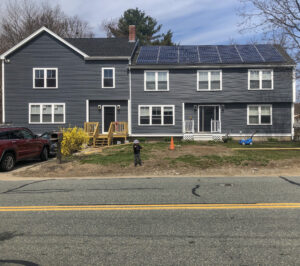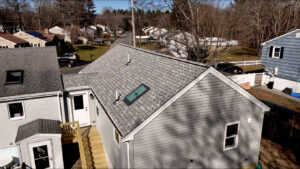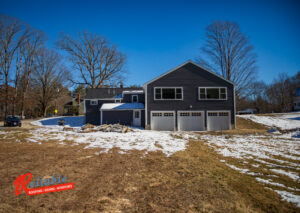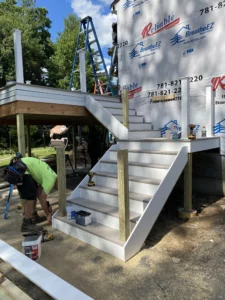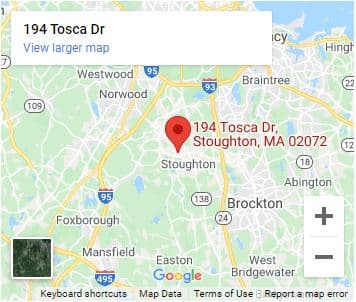What Is An Accessory Dwelling Unit?
A new Massachusetts law allowing Accessory Dwelling Units (ADUs) to be built in single-family zoning districts went into effect on February 2, 2025. This new law is part of the Massachusetts Affordable Homes Act, which was signed on August 6, 2024.
This historic legislation provides $5.16 billion in spending over the next five years and nearly 50 policy initiatives that will directly counter rising housing costs caused by high demand and limited supply.
Learn how you can build almost-instant equity with a new accessory dwelling unit.
An Accessory dwelling unit (ADU) is a self-contained living space built on the same lot as a primary residence. It is either internal to the main house, an attached addition to the main house, or detached from the main house. It typically includes its kitchen, bathroom, living area, and sleeping space, making it fully functional for independent living.
3 Main Accessory Dwelling Unit Configurations
Internal Accessory Dwelling Unit
An Internal Accessory Dwelling Unit (IADU) is a separate living space created within a home’s structure. This could involve transforming areas like basements, attics, or sections of the main house into independent units with their own kitchen, bathroom, and living area. IADUs offer a practical way to utilize unused or underused spaces, providing additional housing options without altering the home’s exterior appearance.
Attached Accessory Dwelling Unit
An Attached Accessory Dwelling Unit (AADU) is a secondary living space that shares at least one common wall with the primary residence. This type of ADU can be an addition to the existing structure or a conversion of an existing space like a garage. Attached ADUs are an excellent option for homeowners looking for a separate living area with privacy, such as in-law additions, all while remaining part of the existing home or the need for a completely separate building.
Detached Accessory Dwelling Units
Detached Accessory Dwelling Units (DADUs) are standalone structures, usually built on a slab foundation, located towards the rear of the primary residence. Unlike attached ADUs, these units are separate structures, such as a backyard pool, guest house, or converted shed or garage.
These ADU options offer occupants more independence and privacy than an internal ADU or an attached ADU, allowing homeowners to generate rental income or a private workshop. Detached ADUs are gaining popularity as flexible and efficient housing solutions, especially in areas facing housing shortages like Massachusetts.
Different Types Of Accessory Dwelling Units
Accessory Dwelling Units (ADUs) are versatile solutions to provide extra living space, support multigenerational households, offer rental income opportunities, and contribute to affordable housing within established neighborhoods.
The optimal configuration of an ADU—be it attached, detached, or internal—depends on local zoning regulations and lot specifications. Understanding the configuration requirements and setbacks is crucial to ensure that the chosen ADU design aligns with personal needs and local zoning bylaws.
Accessory Dwelling Units (ADUs) are versatile living spaces that can be integrated into a property in various ways. Here are some additional types of ADUs:
In-Law Accessory Dwelling Unit
In-law accessory dwelling units, also known as an in-law suite or mother-in-law suite, are separate living spaces within or adjacent to a single-family home designed to provide privacy and independence for aging parents or other family members. These suites typically include a bedroom and full bathroom and may also feature a sitting room or a small kitchen.
The concept of in-law suites has evolved to accommodate multigenerational living arrangements. Historically, secondary suites have existed since the 19th century, taking forms such as coach houses, servant quarters, or stables converted into apartments. They became increasingly popular during the economic crisis of 1929 and the housing shortage following World War II, with the government actively supporting their creation.
However, in the 1950s and ’60s surbanization and new zoning bylaws led to a significant decrease in secondary suites. Their popularity has been resurgent recently, with many municipalities reexamining regulations to support secondary suites.
In modern times, in-law suites have become a practical solution for families seeking to provide relatives with close yet independent living arrangements.
These in-law home additions and ADUs usually have separate living areas with kitchens and bathrooms. The addition can be attached to the main dwelling, such as in a basement, or exist as an external, separate structure like a small cottage on the property.
Beyond housing family members, these suites can serve multiple purposes, including home offices, guest quarters, or rental units, making them a versatile and valuable addition to a property.
Garage Conversion Accessory Dwelling Unit
A garage conversion accessory dwelling unit (ADU) is a great and effective solution to adding living space. This style of ADU involves transforming an existing garage into a self-contained living space that functions independently from the primary residence.
This type of ADU typically includes amenities like a bedroom, bathroom, kitchen, and living area, all within the former garage structure. Garage conversions are particularly appealing because they repurpose existing structures, often resulting in lower construction costs than building new standalone units.
Converting garages into living spaces has evolved as part of broader housing trends. In the early to mid-20th century, many homes were built with detached garages, which became candidates for conversion into living spaces due to changing transportation habits and housing needs. As a viable solution to increased housing shortages and rising costs, municipalities began reintroducing ADUs into zoning regulations in the 1970s.
In recent decades, garage conversions have gained popularity to address housing affordability and density challenges, especially in urban areas. States like Massachusetts have enacted legislation to encourage the development of ADUs, including garage conversions, to increase housing supply.
Basement Conversion Accessory Dwelling Unit
A basement conversion accessory dwelling unit (ADU) involves transforming an existing basement into a self-contained living space within a single-family home. This ADU style is also a great and cost-effective solution for extra living space.
A basement conversion accessory dwelling unit typically includes all of your standard house amenities like a bedroom, bathroom, kitchen, and living area, all accessible through a separate entrance.
Converting a basement to a finished space is particularly appealing because the concept utilizes existing structures, often resulting in lower construction costs than building new standalone units.
Converting basements into livable spaces has significantly evolved over the years.
Notably, basements served primarily as storage areas, providing a calm environment for preserving food or storing household items and equipment. In the 1950s, the purpose of basements began to shift. Homeowners began realizing that converting this underutilized space is a cost-effective and guaranteed way to add more living space to the home.
Basement conversions continue to trend, and today, modern basements offer homeowners a livable space that is indistinguishable from the rest of the house, offering an ADU solution that maximizes space without the need for any site work and foundations.
Attic Conversion Accessory Dwelling Unit
Another popular and cost-effective ADU solution is an attic conversion accessory dwelling unit (ADU). This type of Accessory Dwelling Unit involves transforming attic space, commonly underutilized, into a self-contained living area within a single-family home.
This type of ADU typically includes essential amenities such as a bedroom, bathroom, kitchen, and living area, all accessible through a separate entrance. Attic conversions are particularly appealing because they utilize existing structures, often resulting in lower construction costs than building new standalone units.
The concept of converting attics into livable spaces has significantly evolved.
Historically, attics were primarily used for storage or as servants’ quarters. In the 1960s, particularly in New York’s SoHo district, artists began repurposing abandoned industrial buildings, including their attic spaces, into living and working areas, giving rise to the modern loft movement. This trend highlighted the potential of underutilized spaces for residential purposes.
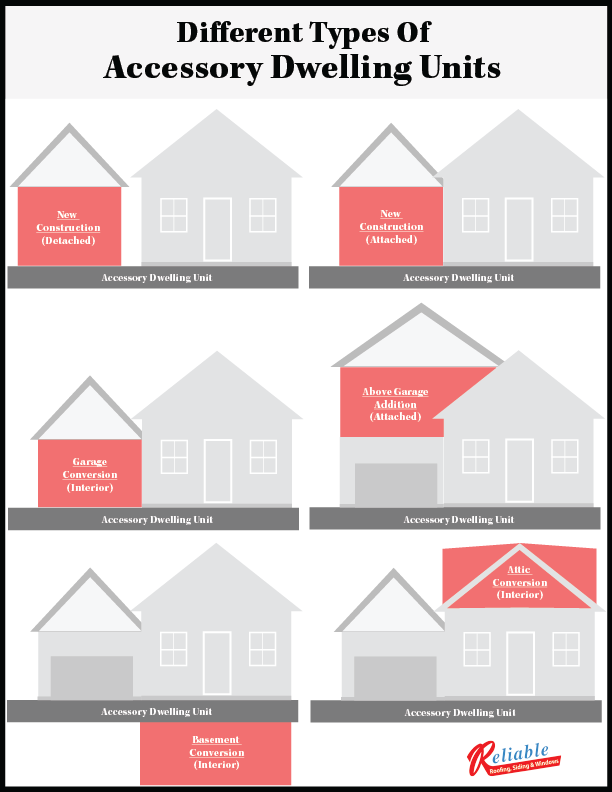
Above-Garage Accessory Dwelling Unit
An above-garage accessory dwelling unit (ADU) is a self-contained living space constructed above an existing or newly built garage on a residential property. This type of ADU typically includes essential amenities such as a bedroom, bathroom, kitchen, and living area, all accessible through a separate entrance. Building an ADU above the garage efficiently maximizes property space without sacrificing yard area or existing structures.
In the 20th century, homeowners would first choose this above-garage addition for additional living space. At this time, carriage houses were typical, acting as storage for horse-drawn carriages with living quarters above for staff or caretakers.
As cars began to replace horse carriages, these structures evolved into garages, and the space above them was often repurposed for various uses, including rental units or guest accommodations.
In recent years, especially in 2025, more homeowners are opting for above-garage ADUs. The reason is simple:
It’s cost-effective, quick, and the uses are endless. Urban planners recognize the benefits of this style of ADU and continue to promote affordability options while highlighting the importance of affordable housing options that can accommodate multigenerational living without expanding the property’s foundation footprint.
Legislative changes in various states, such as Massachusetts ADU reforms, have further encouraged the development of such units by simplifying approval processes and reducing regulatory barriers.
Detached New Construction Accessory Dwelling Units
A Detached New Construction Accessory Dwelling Unit (ADU) is a self-contained residential unit built separately from the primary residence on the same property. Unlike conversions of existing spaces, this type of ADU is newly constructed and stands alone, offering complete living facilities, including a kitchen, bathroom, sleeping area, and living space.
Detached ADUs provide flexibility in design and can be tailored to meet specific needs, such as housing for family members, rental income, or private guest accommodations.
Accessory dwelling units have historical roots in various forms, such as carriage houses, granny flats, and in-law suites.
In the early 20th century, it was common for properties to include secondary units to house extended family or staff. However, post-World War II suburbanization and zoning regulations led to a decline in ADU construction.
In recent years, there has been a resurgence of interest in ADUs as a solution to housing shortages, affordability issues, and the need for flexible living arrangements. States like California have enacted legislation to encourage the development of ADUs, recognizing their potential to increase housing supply and provide diverse housing options.
Junior Accessory Dwelling Units (JADUs)
A Junior Accessory Dwelling Unit (JADU) is a compact, self-contained living space of up to 500 square feet created within the walls of an existing or proposed single-family residence. Unlike standard Accessory Dwelling Units (ADUs), which can be detached or attached structures, JADUs are entirely contained within the primary dwelling. They must include a separate entrance and an efficient kitchen, and they may have individual or shared sanitation facilities with the primary residence.
Creating additional living spaces within existing homes has been a practical solution for accommodating extended family members and guests or generating rental income. Historically, these spaces have been known as “in-law suites” or “granny flats.”
In recent years, particularly in states like California, legislation has been enacted to formalize and encourage the development of such units to address housing shortages and provide affordable living options. The introduction of the JADU classification allows homeowners to legally create smaller, independent living spaces within their homes, promoting efficient use of existing housing stock.
Each type of ADU offers unique benefits and can be tailored to meet specific needs, such as housing family members, generating rental income, or providing a private workspace. When considering adding an ADU, it’s essential to consult local zoning laws and building codes to ensure compliance with regulations.
Massachusetts Legal and Zoning Considerations For ADU Construction
The regulatory framework for Accessory Dwelling Units (ADUs) in Massachusetts has evolved to address housing affordability and flexibility. The Affordable Homes Act, signed into law on August 6, 2024, includes provisions that significantly impact ADU development statewide. Effective February 2, 2025, Section 8 of Chapter 150 of the Acts of 2024 allows ADUs up to 900 square feet to be built by right in single-family zoning districts. This means homeowners can construct an ADU without needing a special permit, provided they adhere to local building codes and reasonable restrictions.
Statewide Provisions
- Reasonable Restrictions: Municipalities may impose reasonable restrictions and requirements for ADUs, such as site plan review and compliance with Title V requirements.
- Prohibited Restrictions: Municipalities cannot require owner occupancy or impose family relationship requirements for the ADU or the principal dwelling.
Local Zoning in Stoughton
In anticipation of the new state law, the Town of Stoughton has proposed an ADU bylaw to align with the upcoming regulations. Key aspects of the proposed bylaw include:
- As-of-Right Allowance: One ADU is permitted as-of-right in all zoning districts where single-family homes are allowed, subject to specific restrictions.
- Dimensional Requirements: An ADU attached to the principal dwelling must comply with all applicable dimensional requirements of the primary residence. Detached ADUs must be located behind the front line of the principal building and maintain a minimum 10-foot setback.
Surrounding Towns
Sharon, Massachusetts
Regulations for ADUs can vary in neighboring communities. For instance, The Town of Sharon, MA, has updated its zoning bylaws to align with new state regulations, allowing one accessory dwelling unit (ADU) as-of-right in all zoning districts where single-family homes are permitted.
To ensure safety and compliance, the ADU must have a separate entrance, either directly from the outside or through a shared entry hall that meets state building code requirements. The entrance can be attached or detached, provided it adheres to fire separation standards.
Additionally, the ADU’s gross floor area cannot exceed half the size of the largest principal dwelling or 900 square feet, whichever is smaller. The unit must also comply with state residential occupancy standards, including adequate water supply and sewage disposal. Further restrictions include a prohibition on using ADUs as short-term rentals.
Canton, Massachusetts
In addition to Sharon, MA, The Town of Canton has updated its zoning bylaws to align with new state regulations, allowing one accessory dwelling unit (ADU) by right in all zoning districts where single-family homes are permitted. The ADU must have a separate entrance that complies with state building code requirements for safe egress and can be either attached or detached while maintaining necessary fire separation.
The unit is limited to half the gross floor area of the largest principal dwelling or 900 square feet, whichever is smaller. Additionally, the ADU must meet all state residential occupancy standards, including proper water and sewage disposal, and cannot be used as a short-term rental.
Recent Legislative Changes
The Affordable Homes Act represents a significant shift in Massachusetts’ approach to ADUs, aiming to increase housing options and affordability. By permitting ADUs by-right in single-family zones and prohibiting specific restrictive municipal requirements, the legislation facilitates the development of ADUs across the state.
Permitting Requirements For ADU Construction
While the new law standardizes certain aspects of ADU construction, homeowners must still comply with local building codes, health and safety regulations, and reasonable local restrictions. It’s advisable to consult with regional planning and building departments to understand specific permitting processes and requirements in your area.
In summary, Massachusetts has enacted legislation to streamline the development of ADUs, promoting them as a viable solution to housing challenges. However, local regulations and requirements may vary, so engaging with municipal authorities is essential to ensure compliance with all applicable laws.
How Much Does An Accessory Dwelling Unit Cost?
Cost Analysis, Financing Options, and Return On Investment
Constructing an Accessory Dwelling Unit (ADU) in Massachusetts involves carefully considering costs, financing options, and potential returns on investment.
Construction and Installation Costs
The total cost of building an ADU in Massachusetts varies based on size, design complexity, materials, and site conditions. On average, construction costs range from $180,000 to $300,000, translating to approximately $185 to $300 per square foot.
Accessory Dwelling Unit (ADU) Financing Options
Homeowners have several avenues to finance ADU construction:
- Home Equity Loans or Lines of Credit (HELOC): These allow you to borrow against the equity in your home, providing a lump sum or a revolving line of credit that can be used for construction expenses.
- Cash-Out Refinance: This option involves refinancing your existing mortgage for more than you owe and using the difference to fund the ADU project.
- Construction Loans: Specialized loans designed to cover the cost of building an ADU, often with interest-only payments during the construction phase.
- Government Programs: Some localities offer grants or low-interest loans for ADU construction, mainly if the unit will be used for affordable housing.
Return on Investment (ROI)
Investing in an ADU can yield financial benefits through rental income and increased property value:
- Rental Income: An ADU can be a long-term rental unit, generating a steady income stream. The rental rate will depend on local market conditions, unit size, and amenities.
- Property Value: Adding an ADU can enhance your property’s value by increasing its livable space and potential income generation. In competitive housing markets, properties with ADUs may attract higher resale prices.
While the initial investment in building an ADU can be substantial, the combination of rental income and increased property value can offer a favorable return over time. Conducting a thorough cost-benefit analysis and consulting with financial advisors to determine the best financing strategy for your situation is essential.
Two Primary Building Methods In ADU Construction
When considering ADU construction, two primary methods are prevalent: on-site (stick-built) construction and prefabricated (prefab) units.
On-Site (Stick-Built) Construction
This traditional approach uses standard construction methods to build the ADU directly on the property. Materials are delivered to the site, and the structure is assembled piece by piece.
Advantages:
- Customization: Allows tailored designs that match the existing home and meet specific homeowner needs.
- Quality Control: Enables close monitoring of construction processes, ensuring adherence to high standards.
- Integration: Facilitates seamless blending with the existing property’s aesthetics and infrastructure.
Prefabricated (Prefab) Units
Prefab ADUs are manufactured off-site in factories and then transported to the property for installation. This category includes modular and panelized units.
Advantages
- Speed: Construction in a controlled environment can reduce building time.
- Cost Efficiency: Bulk purchasing and reduced labor can lower expenses.
- Project Efficiency: Everything is handled in-house, which means we ensure timelines are followed, trades are on-site when they are supposed to be, and the job is completed within a reasonable timeframe.
- Environmental Control: Factory settings minimize weather-related delays and material exposure.
Considerations For ADU Home Additions
- Design Limitations: This may offer less flexibility in customization.
- Transportation Challenges: Moving large manufactured homes can be logistically complex.
- Site Compatibility: Proper measurements, locations, and precise site preparation are required to accommodate the unit.
Commitment to On-Site Construction
At Reliable Roofing, Siding, and Windows, we advocate for on-site construction of ADUs. This preference stems from our dedication to quality and craftsmanship.
Quality Assurance
Building on-site allows our team to manage each phase of construction meticulously. We ensure that all installation methods adhere to industry best practices, resulting in a durable and well-integrated structure.
Extended Warranty
Unlike Massachusetts’s standard one-year labor warranty, Reliable stands by our workmanship with a ten-year warranty. This commitment reflects our confidence in the quality of our builds and provides homeowners with long-term peace of mind.
In summary, while both on-site and prefab construction methods have their merits, Reliable Roofing, Siding, and Windows believe that the control and assurance provided by on-site building best serve our client’s interests. Our approach ensures that each ADU is constructed with precision, care, and a commitment to lasting quality.
ADUs: The Adaptive Home Solution for Family Life, Workspaces, and Rental Income
Accessory Dwelling Units (ADUs) have proven remarkably versatile in meeting various housing needs. Whether they provide additional living space for extended family members, a dedicated workspace, or an income-generating rental unit, ADUs can be seamlessly integrated into a variety of lifestyles and adapt as those needs evolve over time.
Below are some everyday use cases and lifestyle integrations for ADUs:
Multi-generational Living
Family Support and Aging in Place:
ADUs are frequently used to support multigenerational living arrangements. For instance, an elderly parent can reside in a separate yet conveniently located unit that offers privacy while remaining close to family. This setup enables caregivers to provide support as needed, all within the same property.
Enhanced Independence:
By creating a separate living space for adult children or extended family, households can maintain independence and closeness, allowing members to live together without sacrificing privacy.
Peace Of Mind and Financial Freedom:
How can an accessory dwelling unit provide a person or family peace of mind and financial freedom? Accessory Dwelling Units allow families and friends to live together but separately while pooling money to work together.
Imagine your elderly parents worked their entire lives, and now they are unable to afford rent and groceries and to keep the heat on, and to add to it, they can’t work. They are on a fixed income and have worked hard to barely afford to live. The best solution to this problem would be multigenerational living by either an in-law addition.
Home Office or Studio Space
Remote Work Flexibility:
With the rise in remote work and telecommuting, many homeowners are converting ADUs into dedicated home offices. A well-designed ADU office can provide a quiet, distraction-free environment that boosts productivity, separates work from home life, and even offers the possibility of hosting client meetings in a professional setting.
Creative and Hobby Spaces:
Beyond serving as conventional offices, ADUs can also be tailored into studios for artists, musicians, or designers, providing the creative space required for hobbies or professional pursuits.
Generating Rental Income
Long-Term Rental Solutions:
Many homeowners rent out their ADUs as a source of steady rental income. This can help offset mortgage costs and contribute to long-term financial stability.
Short-Term Rental Opportunities:
In some markets, ADUs are ideal for short-term rentals, providing travelers or temporary residents with affordable, private lodging. This can be especially beneficial in urban areas or near major transit hubs.
Investment Flexibility
ADUs offer an adaptable investment option. As market conditions change, a rental unit can be converted into personal space, used as a home office, or maintained as a long-term income stream.
Please consult with your local building department and zoning by-laws before assuming any rights to renting.
Adaptability to Changing Lifestyles
Evolving Family Needs:
One of the strongest points about ADUs is their ability to evolve with the family. A unit initially designed as a home office can later be reconfigured as a guest house or an additional living space for growing families.
Future-Proofing:
As family life dynamics change—whether due to children growing up, parents needing care, or shifts in work-life balance—ADUs provide a flexible solution that can be remodeled or repurposed to suit emerging needs. This flexibility not only enhances a property’s functionality but can also add long-term value.
